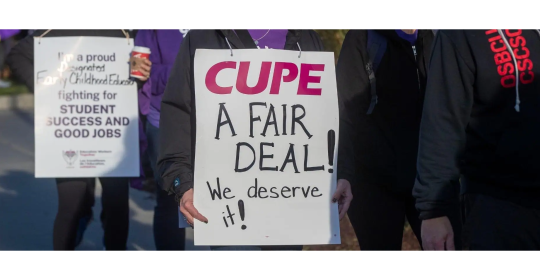
Analysis: Bill 28 and Union Fightback
This essay won the Canadian Association of Labour Media’s 2023 Morden Lazarus Award for best editorial, column, or opinion piece that thoughtfully argues labour’s position on an issue.
It’s been a fascinating few months in Canadian public-sector bargaining. Here in British Columbia, the provincial bargaining mandate has been set. The BC General Employees’ Union (BCGEU) and Hospital Employees’ Union (HEU) ratified collective agreements with identical duration and monetary terms in October. While the wage guarantees of BCGEU and HEU fail to keep up with inflation, they nevertheless lead the country in recent public-sector monetary gains. The BC Teachers’ Federation (BCTF) has also sent a tentative agreement to its membership for ratification. Although details of the BCTF deal have yet to be released, it is expected to principally mirror HEU and BCGEU contract gains.
The establishment of a public-sector bargaining pattern in BC will directly affect FSA members. Yet labour struggles in Ontario at the end of October and early November may well reverberate throughout the union movement Canada-wide for years. The progression of events between CUPE’s Ontario School Board Council of Unions (OSBCU), whose workers perform in-school education, and the Progressive Conservative (PC) government of Ontario is well known but bears repeating. On Hallowe’en 2022, the PCs, who holds a majority in the province, introduced legislation to prevent OSBCU education workers from striking. Bill 28, insincerely called the Keeping Students in Class Act, imposed a new collective agreement and pre-emptively prohibited any strike activity—at a potential cost of up to $200 million per day for the union if members defied the Act and exercised their right to strike.
OSBCU education workers earn on average $39,000 annually, with wages falling well behind inflation over the past decade. One in five members report that their children are unable to participate in extra curricular activities because of low pay, just under half struggle to pay monthly bills and afford essential items, 40% report poor mental health, and over a third have to borrow money.
The Bill overrides sections of the Canadian Charter of Rights and Freedoms and directly contradicts recent Supreme Court judgments that affirm the right to strike. More alarmingly, the Ford government signalled its intention to use the notwithstanding clause to insulate the legislation from legal challenges it almost certainly would lose. In tabling the legislation in this manner, the government became the first in Canadian history to use the clause to extinguish Charter-protected labour rights. The Bill received Royal Assent on November 3.
With their Charter rights imperiled, it was workers themselves and not the courts that caused the Ford government to agree to repeal the legislation on November 7. One day after the legislation passed, tens of thousands of workers—risking massive fines—walked off the job in protest, joined by educators in the Ontario Public Sector Employees’ Union, among other union supporters. By the end of the weekend, murmurs of a general strike among the Ontario public sector were all but officially confirmed, with a CUPE Ontario/OSBCU-led press conference planned for Monday. The conference would feature about 30 labour leaders representing “what looks like nearly every major public and private sector union in Canada.” Unions from across the country also supported OSBCU with offers of monetary and in-kind support along with solidarity actions in conjunction with planned protests in Ontario. Faced with unprecedented backlash, the Ford government backed down and committed in writing to CUPE to withdraw the legislation and return to the bargaining table.
This was a stunning show of solidarity, and the credible threat of general strike in Ontario is a potential apogee in recent Canadian labour history. The strength of workers to come quickly together in solidarity to oppose Bill 28 calls to mind the rationale behind the 2007 Supreme Court of Canada decision to proclaim collective bargaining a constitutional right supported the Charter’s freedom of association provision. In that decision, the Court recognized that collective action is inherently valuable as a form of self-government and is at the core of freedom of expression. The right to strike was later enshrined as a Charter right, in part because the right is a critical element of any regime of free and fair collective bargaining.
The Ford government’s Bill 28 was an attack on vulnerable, low-wage workers in a highly gendered profession. The fact that CUPE-OSBCU and other public and private-sector unions won has national implications. Anti-union sentiment runs deep in British Columbia and previous Liberal governments have not been shy about undermining the bargaining power of unions. If the right-to-strike could be pre-empted by government and contracts imposed by decree, the entire system of free and fair collective bargaining is irrelevant. Although Ford’s use of the notwithstanding clause to pre-empt a public-sector strike was exceptional, there is no reason to believe that this will be the last such occurrence.
The dual lessons from Ontario are that aspects of our Charter may be used against the interests of working people when in the hands of anti-labour governments. Yet the power of workers to intervene and organize to stop the business of the province can, if used well, ultimately win the day. While all workers have the potential to interrupt their labour process, this potential needs to be mobilized as it was in Ontario. Courts are insufficient to protect our rights. Our rights are only as strong as our ability to organize.
Leave a reply →